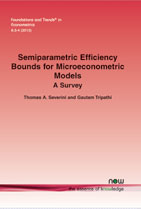Semiparametric Efficiency Bounds for Microeconometric Models: A Survey
By Thomas A. Severini, Department of Statistics, Northwestern University, USA, severini@northwestern.edu | Gautam Tripathi, Faculty of Law, Economics and Finance, University of Luxembourg, Luxembourg, gautam.tripathi@uni.lu
Abstract
In this survey, we evaluate estimators by comparing their asymptotic variances. The role of the efficiency bound, in this context, is to give a lower bound to the asymptotic variance of an estimator. An estimator with asymptotic variance equal to the efficiency bound can therefore be said to be asymptotically efficient. These bounds are also useful for understanding how the features of a given model affect the accuracy of parameter estimation.
Semiparametric Efficiency Bounds for Microeconometric Models
Semiparametric Efficiency Bounds for Microeconometric Models: A Survey offers a partial review of the vast literature in econometrics and statistics on calculating semiparametric efficiency bounds for a large class of models used in applied economics research. The main role of the efficiency bound is to give a lower bound to the asymptotic variance of an estimator. An estimator with asymptotic variance equal to the efficiency bound can therefore be said to be asymptotically efficient. These bounds are also useful for understanding how the features of a given model affect the accuracy of parameter estimation. This monograph will help researchers learn more about efficiency bounds, their calculation, and their usefulness in semiparametric estimation, in an accessible manner.
